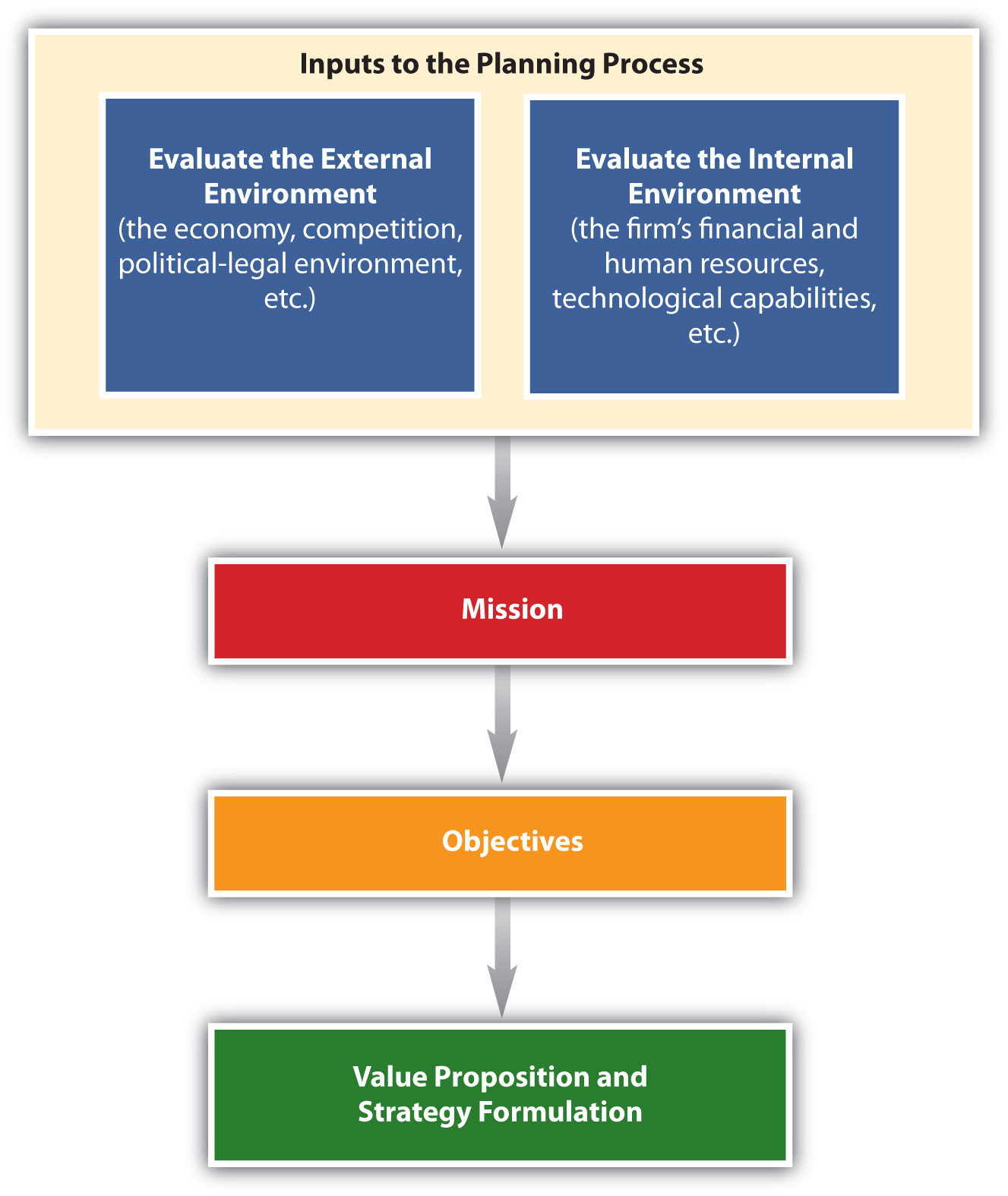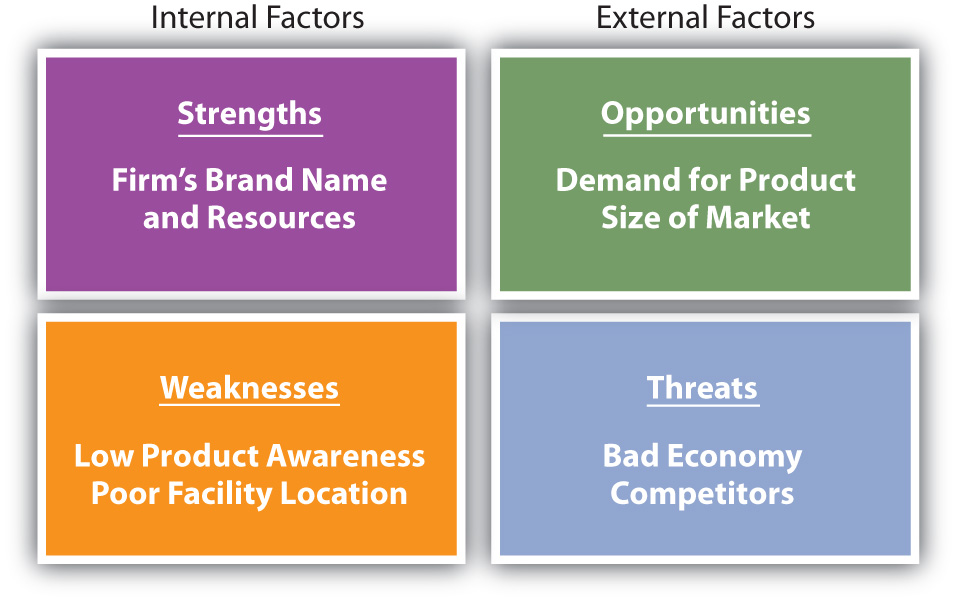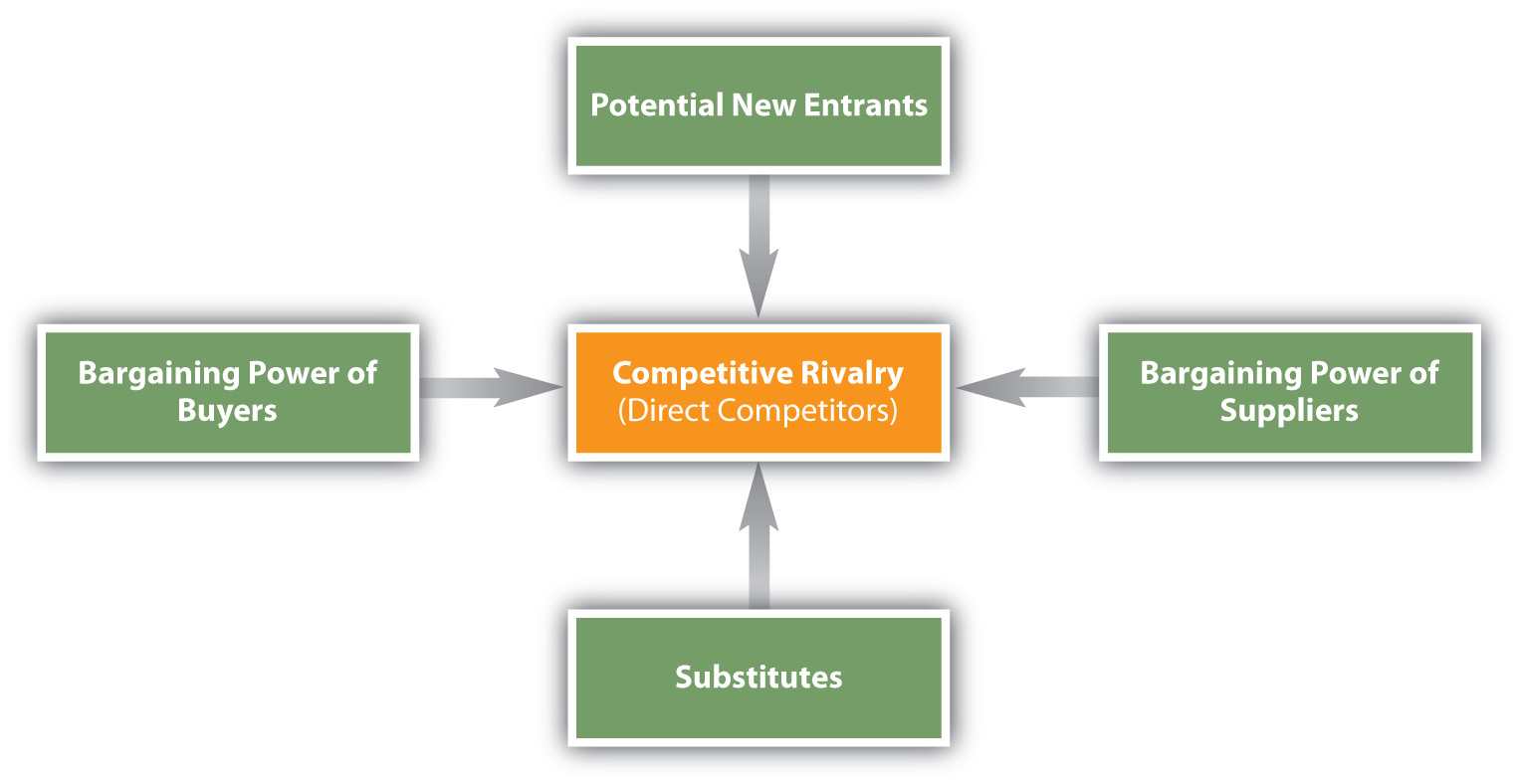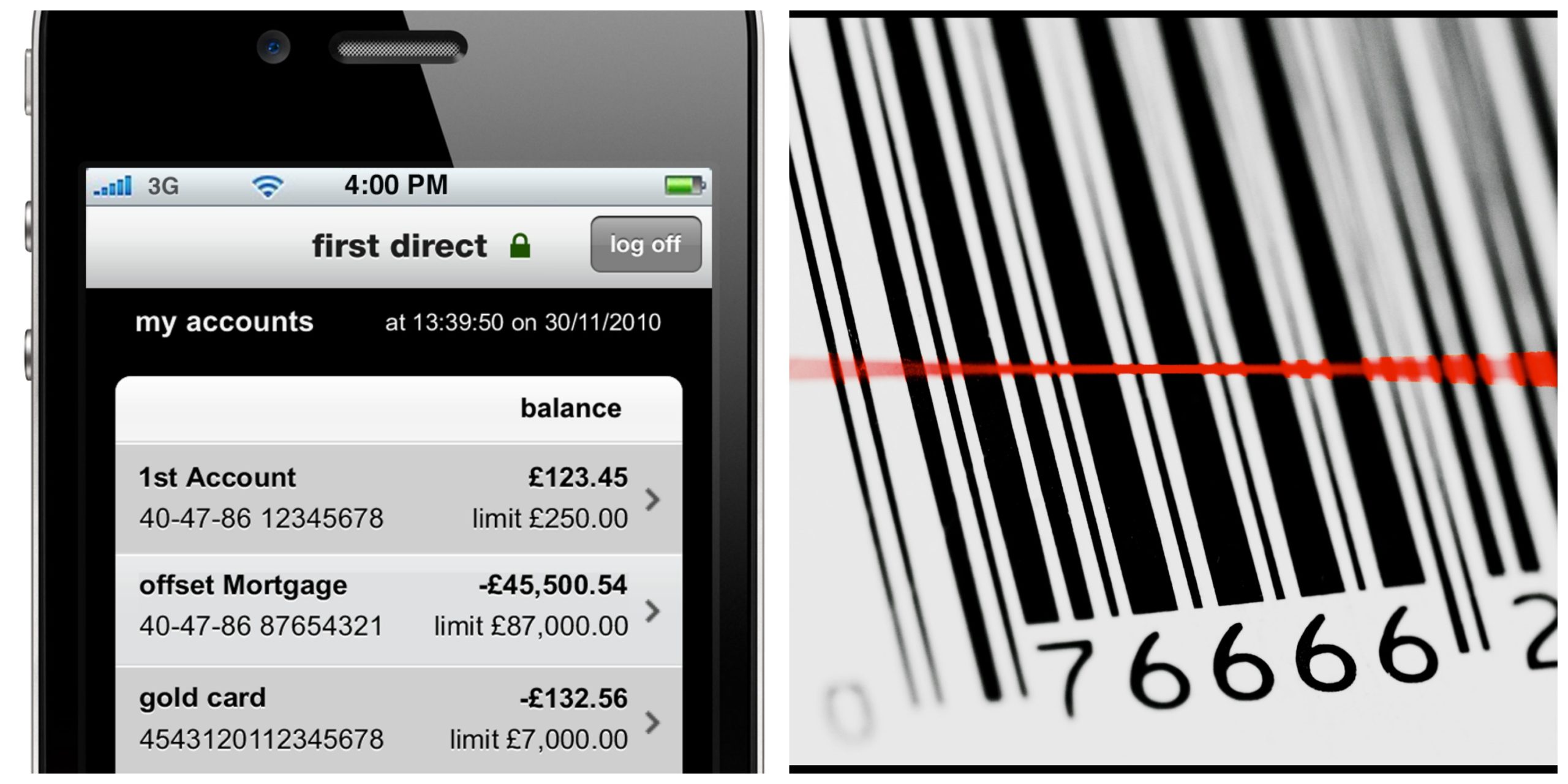Chapter 2: Strategic Planning
2.2 Components of the Strategic Planning Process
Learning Objectives
- Explain how a mission statement helps a company with its strategic planning.
- Describe how a firm analyzes its internal environment.
- Describe the external environment a firm may face and how it is analyzed.
Strategic planning is a process that helps an organization allocate its resources to capitalize on opportunities in the marketplace. Typically, it is a long-term process. The strategic planning process includes conducting a situation analysis and developing the organization’s mission statement, objectives, value proposition, and strategies. Figure 2.2 “The Strategic Planning Process” shows the components of the strategic planning process. Let’s now look at each of these components.

Conducting a Situation Analysis
As part of the strategic planning process, a situation analysis must be conducted before a company can decide on specific actions. A situation analysis involves analyzing both the external (macro and micro factors outside the organization) and the internal (company) environments. Figure 2.2 “The Strategic Planning Process” and Figure 2.3 “Elements of a SWOT Analysis” show examples of internal and external factors and in a SWOT analysis. The firm’s internal environment—such as its financial resources, technological resources, and the capabilities of its personnel and their performance—has to be examined. It is also critical to examine the external macro and micro environments the firm faces, such as the economy and its competitors. The external environment significantly affects the decisions a firm makes and thus must be continuously evaluated. For example, during the economic downturn in 2008–2009, businesses found that many competitors cut the prices of their products drastically. Other companies reduced package sizes or the amount of product in packages. Firms also offered customers incentives (free shipping, free gift cards with purchase, rebates, etc.) to purchase their goods and services online, which allowed businesses to cut back on the personnel needed to staff their brick-and-mortar stores. While a business cannot control things such as the economy, changes in demographic trends, or what competitors do, it must decide what actions to take to remain competitive—actions that depend in part on their internal environment.
Conducting a SWOT Analysis
Based on the situation analysis, organizations analyze their strengths, weaknesses, opportunities, and threats, or conduct what’s called a SWOT analysis. Strengths and weaknesses are internal factors and are somewhat controllable. For example, an organization’s strengths might include its brand name, efficient distribution network, reputation for great service, and strong financial position. A firm’s weaknesses might include a lack of awareness of its products in the marketplace, a lack of human resources talent, and a poor location. Opportunities and threats are factors that are external to the firm and largely uncontrollable. Opportunities might entail the international demand for the type of products the firm makes, few competitors, and favourable social trends such as people living longer. Threats might include a bad economy, high interest rates that increase a firm’s borrowing costs, and an ageing population that makes it hard for the business to find workers.
You can conduct a SWOT analysis of yourself to help determine your competitive advantage. Perhaps your strengths include strong leadership abilities and communication skills, whereas your weaknesses include a lack of organization. Opportunities for you might exist in specific careers and industries; however, the economy and other people competing for the same position might be threats. Moreover, a factor that is a strength for one person (say, strong accounting skills) might be a weakness for another person (poor accounting skills). The same is true for businesses. See Figure 2.3 “Elements of a SWOT Analysis” for an illustration of some of the factors examined in a SWOT analysis.

The easiest way to determine if a factor is external or internal is to take away the company, organization, or individual and see if the factor still exists. Internal factors such as strengths and weaknesses are specific to a company or individual, whereas external factors such as opportunities and threats affect multiple individuals and organizations in the marketplace. For example, if you are doing a situation analysis on PepsiCo and are looking at the weak economy, take PepsiCo out of the picture and see what factors remain. If the factor—the weak economy—is still there, it is an external factor. Even if PepsiCo hadn’t been around in 2008–2009, the weak economy reduced consumer spending and affected a lot of companies.
Assessing the Internal Environment
As we have indicated, when an organization evaluates which factors are its strengths and weaknesses, it is assessing its internal environment. Once companies determine their strengths, they can use those strengths to capitalize on opportunities and develop their competitive advantage. For example, strengths for PepsiCo are what are called “mega” brands, or brands that individually generate over $1 billion in sales.[1] These brands are also designed to contribute to PepsiCo’s environmental and social responsibilities.
PepsiCo’s brand awareness, profitability, and strong presence in global markets are also strengths. Especially in foreign markets, the loyalty of a firm’s employees can be a major strength, which can provide it with a competitive advantage. Loyal and knowledgeable employees are easier to train and tend to develop better relationships with customers. This helps organizations pursue more opportunities.
Although the brand awareness for PepsiCo’s products is strong, smaller companies often struggle with weaknesses such as low brand awareness, low financial reserves, and poor locations. When organizations assess their internal environments, they must look at factors such as performance and costs as well as brand awareness and location. Managers need to examine both the past and current strategies of their firms and determine what strategies succeeded and which ones failed. This helps a company plan its future actions and improves the odds they will be successful. For example, a company might look at packaging that worked very well for a product and use the same type of packaging for new products. Firms may also look at customers’ reactions to changes in products, including packaging, to see what works and doesn’t work. When PepsiCo changed the packaging of major brands in 2008, customers had mixed responses. Tropicana switched from the familiar orange with the straw in it to a new package and customers did not like it. As a result, Tropicana changed back to their familiar orange with a straw after spending $35 million for the new package design.
Watch the video: Tropicana Presents: An Orange America (30 seconds)
Individuals are also wise to look at the strategies they have tried in the past to see which ones failed and which ones succeeded. Have you ever done poorly on an exam? Was it the instructor’s fault, the strategy you used to study, or did you decide not to study? See which strategies work best for you and perhaps try the same type of strategies for future exams. If a strategy did not work, see what went wrong and change it. Doing so is similar to what organizations do when they analyze their internal environments.
Assessing the External Environment
Analyzing the external environment involves tracking conditions in the macro and micro marketplace that, although largely uncontrollable, affect the way an organization does business. The macro-environment includes economic factors, demographic trends, cultural and social trends, political and legal regulations, technological changes, and the price and availability of natural resources. Each factor in the macro environment is discussed separately in the next section. The micro-environment includes competition, suppliers, marketing intermediaries (retailers, wholesalers), the public, the company, and customers. We focus on competition in our discussion of the external environment in the chapter. Customers, including the public, will be the focus of Chapter 3 “Consumer Behavior: How People Make Buying Decisions” and marketing intermediaries and suppliers will be discussed in Chapter 8 “Using Marketing Channels to Create Value for Customers” and Chapter 9 “Using Supply Chains to Create Value for Customers”.
When firms globalize, analyzing the environment becomes more complex because they must examine the external environment in each country in which they do business. Regulations, competitors, technological development, and the economy may be different in each country and will affect how firms do business. To see how factors in the external environment such as technology may change education and lives of people around the world, watch the video “Did You Know 2.0?,” which provides information on social media sites compared to populations in the world. Originally created in 2006 and revised in 2007, the video has been updated and translated into other languages. Another edition of “Did You Know?” (4.0) focused on changing media and technology and showed how information may change the world as well as the way people communicate and conduct business.
To see how the external environment and world are changing and in turn affecting marketing strategies, watch “Did You Know 2.0?”
Watch the video: Did You Know 2.0 (8 minutes)
To see how fast things change and the impact of technology and social media, watch “Did You Know 4.0?”
Watch the video: Did you Know 4.0 (4 minutes)
Although the external environment affects all organizations, companies must focus on factors that are relevant for their operations. For example, government regulations on food packaging will affect PepsiCo but not Goodyear. Similarly, students getting a business degree don’t need to focus on job opportunities for registered nurses.
Activity: Can you distinguish between factors of the internal vs. the external environment of the firm?
The Competitive Environment
All organizations must consider their competition, whether it is direct or indirect competition vying for the consumer’s dollar. Both nonprofit and for-profit organizations compete for customers’ resources. Coke and Pepsi are direct competitors in the soft drink industry, Hilton and Sheraton are competitors in the hospitality industry, and organizations such as United Way and the American Cancer Society compete for resources in the nonprofit sector. However, hotels must also consider other options that people have when selecting a place to stay, such as hostels, dorms, bed and breakfasts, or rental homes.
A group of competitors that provide similar products or services form an industry. Michael Porter, a professor at Harvard University and a leading authority on competitive strategy, developed an approach for analyzing industries. Called the five forces model (Porter, 1980) and shown in Figure 2.5 “Five Forces Model”, the framework helps organizations understand their current competitors as well as organizations that could become competitors in the future. As such, firms can find the best way to defend their position in the industry.

Competitive Analysis
When a firm conducts a competitive analysis, they tend to focus on direct competitors and try to determine a firm’s strengths and weaknesses, its image, and its resources. Doing so helps the firm figure out how much money a competitor may be able to spend on things such as research, new product development, promotion, and new locations. Competitive analysis involves looking at any information (annual reports, financial statements, news stories, observation details obtained on visits, etc.) available on competitors. Another means of collecting competitive information utilizes mystery shoppers or people who act as customers. Mystery shoppers might visit competitors to learn about their customer service and their products. Imagine going to a competitor’s restaurant and studying the menu and the prices and watching customers to see what items are popular and then changing your menu to better compete. Competitors battle for the customer’s dollar and they must know what other firms are doing. Individuals and teams also compete for jobs, titles, and prizes and must figure out the competitors’ weaknesses and plans in order to take advantage of their strengths and have a better chance of winning.
According to Porter, in addition to their direct competitors (competitive rivals), organizations must consider the strength and impact the following could have (Porter, 1980):
- Substitute products
- Potential entrants (new competitors) in the marketplace
- The bargaining power of suppliers
- The bargaining power of buyers
When any of these factors change, companies may have to respond by changing their strategies. For example, because buyers are consuming fewer soft drinks these days, companies such as Coke and Pepsi have had to develop new, substitute offerings such as vitamin water and sports drinks. However, other companies such as Dannon or Nestlé may also be potential entrants in the flavoured water market. When you select a hamburger fast-food chain, you also had the option of substitutes such as getting food at the grocery or going to a pizza place. When computers entered the market, they were a substitute for typewriters. Most students may not have ever used a typewriter, but some consumers still use typewriters for forms and letters.

Suppliers, the companies that supply ingredients as well as packaging materials to other companies, must also be considered. If a company cannot get the supplies it needs, it’s in trouble. Also, sometimes suppliers see how lucrative their customers’ markets are and decide to enter them. Buyers, who are the focus of marketing and strategic plans, must also be considered because they have bargaining power and must be satisfied. If a buyer is large enough and doesn’t purchase a product or service, it can affect a selling company’s performance. Walmart, for instance, is a buyer with a great deal of bargaining power. Firms that do business with Walmart must be prepared to make concessions to them if they want their products on the company’s store shelves.
Lastly, the world is becoming “smaller” and more of a global marketplace. Companies everywhere are finding that no matter what they make, numerous firms around the world are producing the same “widget” or a similar offering (substitute) and are eager to compete with them. Employees are in the same position. The Internet has made it easier than ever for customers to find products and services and for workers to find the best jobs available, even if they are abroad. Companies are also acquiring foreign firms. These factors all have an effect on the strategic decisions companies make.
The Political and Legal Environment
All organizations must comply with government regulations and understand the political and legal environments in which they do business. Different government agencies enforce the numerous regulations that have been established to protect both consumers and businesses. For example, the Sherman Act (1890) prohibits U.S. firms from restraining trade by creating monopolies and cartels. The regulations related to the act are enforced by the Federal Trade Commission (FTC), which also regulates deceptive advertising. The U.S. Food and Drug Administration (FDA) regulates the labelling of consumable products, such as food and medicine. One organization that has been extremely busy is the Consumer Product Safety Commission, the group that sets safety standards for consumer products. Unsafe baby formula and toys with lead paint caused a big scare among consumers in 2008 and 2009.

As we have explained, when organizations conduct business in multiple markets, they must understand that regulations vary across countries and across states. Many states and countries have different laws that affect strategy. For example, suppose you are opening up a new factory because you cannot keep up with the demand for your products. If you are considering opening the factory in France (perhaps because the demand in Europe for your product is strong), you need to know that it is illegal for employees in that country to work more than thirty-five hours per week.
The Economic Environment
The economy has a major impact on spending by both consumers and businesses, which, in turn, affects the goals and strategies of organizations. Economic factors include variables such as inflation, unemployment, interest rates, and whether the economy is in a growth period or a recession. Inflation occurs when the cost of living continues to rise, eroding the purchasing power of money. When this happens, you and other consumers and businesses need more money to purchase goods and services. Interest rates often rise when inflation rises. Recessions can also occur when inflation rises because higher prices sometimes cause low or negative growth in the economy.
During a recessionary period, it is possible for both high-end and low-end products to sell well. Consumers who can afford luxury goods may continue to buy them, while consumers with lower incomes tend to become more value-conscious. Other goods and services, such as products sold in traditional department stores, may suffer. In the face of a severe economic downturn, even the sales of luxury goods can suffer. The economic downturn that began in 2008 affected consumers and businesses at all levels worldwide. Consumers reduced their spending, holiday sales dropped, financial institutions went bankrupt, the mortgage industry collapsed, and the “Big Three” U.S. auto manufacturers (Ford, Chrysler, and General Motors) asked for emergency loans.
The demographic and social and cultural environments—including social trends, such as people’s attitudes toward fitness and nutrition; demographic characteristics, such as people’s age, income, marital status, education, and occupation; and culture, which relates to people’s beliefs and values—are constantly changing in the global marketplace. Fitness, nutrition, and health trends affect the product offerings of many firms. For example, PepsiCo produces vitamin water and sports drinks. More women are working, which has led to a rise in the demand for services such as house cleaning and daycare. U.S. baby boomers are reaching retirement age, sending their children to college, and trying to care of their elderly parents all at the same time. Firms are responding to the time constraints their buyers face by creating products that are more convenient, such as frozen meals and nutritious snacks.
The composition of the population is also constantly changing. Hispanics are the fastest-growing minority in the United States. Consumers in this group and other diverse groups prefer different types of products and brands. In many cities, stores cater specifically to Hispanic customers.
Technology
The technology available in the world is changing the way people communicate and the way firms do business. Everyone is affected by technological changes. Self-scanners and video displays at stores, ATMs, the Internet, and mobile phones are a few examples of how technology is affecting businesses and consumers. Many consumers get information, read the news, use text messaging, and shop online. As a result, marketers have begun allocating more of their promotion budgets to online ads and mobile marketing and not just to traditional print media such as newspapers and magazines. Applications for telephones and electronic devices are changing the way people obtain information and shop, allowing customers to comparison shop without having to visit multiple stores. As you saw in “Did You Know 4.0?” technology and social media are changing people’s lives. Many young people may rely more on electronic books, magazines, and newspapers and depend on mobile devices for most of their information needs. Organizations must adapt to new technologies in order to succeed.

Natural Resources
Natural resources are scarce commodities, and consumers are becoming increasingly aware of this fact. Today, many firms are doing more to engage in “sustainable” practices that help protect the environment and conserve natural resources. Green marketing involves marketing environmentally safe products and services in a way that is good for the environment. Water shortages often occur in the summer months, so many restaurants now only serve patrons water upon request. Hotels voluntarily conserve water by not washing guests’ sheets and towels every day unless they request it. Reusing packages (refillable containers) and reducing the amount of packaging, paper, energy, and water in the production of goods and services are becoming key considerations for many organizations, whether they sell their products to other businesses or to final users (consumers). Construction companies are using more energy-efficient materials and often have to comply with green building solutions. Green marketing not only helps the environment but also saves the company, and ultimately the consumer, money. Sustainability, ethics (doing the right things), and social responsibility (helping society, communities, and other people) influence an organization’s planning process and the strategies they implement.
Although environmental conditions change and must be monitored continuously, the situation analysis is a critical input to an organization’s or an individual’s strategic plan. Let’s look at the other components of the strategic planning process.
The Mission Statement
The firm’s mission statement states the purpose of the organization and why it exists. Both profit and nonprofit organizations have mission statements, which they often publicize. The following are examples of mission statements:
- PepsiCo’s Mission Statement: “Our mission is to be the world’s premier consumer products company focused on convenient foods and beverages. We seek to produce financial rewards to investors as we provide opportunities for growth and enrichment to our employees, our business partners and the communities in which we operate. And in everything we do, we strive for honesty, fairness and integrity.[2]”
- The United Way’s Mission Statement: “To improve lives by mobilizing the caring power of communities.[3]”
Sometimes SBUs develop separate mission statements. For example, PepsiCo Americas Beverages, PepsiCo Americas Foods, and PepsiCo International might each develop a different mission statement.
Key Takeaways
A firm must analyze factors in the external and internal environments it faces throughout the strategic planning process. These factors are inputs to the planning process. As they change, the company must be prepared to adjust its plans. Different factors are relevant for different companies. Once a company has analyzed its internal and external environments, managers can begin to decide which strategies are best, given the firm’s mission statement.
Review Questions
- What factors in the external environment are affecting the “Big Three” U.S. automobile manufacturers?
- What are some examples of Walmart’s strengths?
- Suppose you work for a major hotel chain. Using Porter’s five forces model, explain what you need to consider with regard to each force.
References
Porter, M. E., Competitive Strategy (New York: The Free Press, 1980), 3–33.
Media Attributions
- “Smith-Corona Classic 12” by mpclemens is licensed under a CC BY 2.0 licence.
- ““Sarge” die cast toy cars” by Consumer product safety commission is is in the public domain.
- “first direct Banking ‘on the go’ iPhone App – front” by first direct is licensed under a CC BY-NC-ND 2.0 licence.
- PepsiCo, Inc., “PepsiCo Brands,"https://web.archive.org/web/20140819052110/http://www.pepsico.com:80/Company/Global-Brands.html (accessed July 20, 2021). ↵
- PepsiCo, Inc., “Our Mission and Vision,” https://web.archive.org/web/20100511055019/http://www.pepsico.com/Company/Our-Mission-and-Vision.html (accessed July 20, 2021). ↵
- United Way Worldwide, “Mission and Vision,” https://web.archive.org/web/20080417092224/http://www.unitedway.org/about/missvis.cfm (accessed July 20, 2021). ↵

